

![]()
VOC
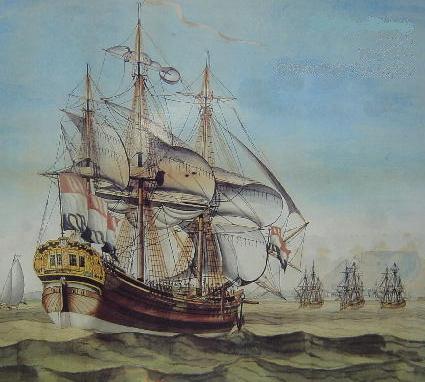
Latest news!
All the original VOC's archives are kept in the National Archives at The Hague. There has been a project on for some time to transfer all information in the handwritten ledgers regarding all crew members who ever sailed in VOC ships and that during the entire period that the VOC existed. It was customary in these days to keep accurate books on almost anything. Also of each crew member the name, the rank, the ship, the voyage and the salary were meticulously recorded in voluminous ledgers. The characters in these ledgers are rather hard to read because of the gothic-like style of writing then used. I understand that all the information will be made available on the internet. It is very easy then to look up an ancestor who might have been sailing on one of the VOC ships. Until now that was quite impossible. The possibilities that the on-line ledgers will offer are enormous, especially for those interested in genealogy. The planning is that the web site will be fully functional as from March 2, 2002. From that date you can try your luck on the following URL: http://voc.websilon.nl
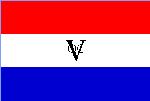
Today, February 28, 2002 I found the above mentioned link in operation! However, up to now the database contains 50.000 names from the ship's salary ledgers and only those persons who sailed on ships of the Delft Chamber of the VOC. Apart from Delft also the VOC Chambers of Amsterdam, Enkhuizen, Hoorn Middelburg and Rotterdam had their own fleets of vessels. The total number of crew who sailed on the VOC's ships amounts to 700.000! So more is yet to come....
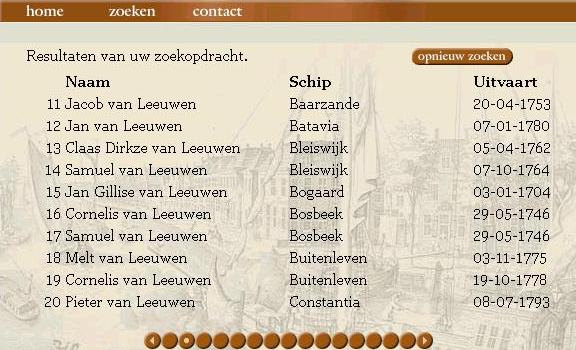
This is an example of a search for the name 'van Leeuwen' My last name van Eeuwen was not amongst the names in the VOC's Delft Chamber's crew lists! As soon as the other 650.000 names are 'on line' I will have another look.
This is a part of the title page of the 'Journaal van de reyse der Hollandtsche schepen' (Journal of the voyage of the Dutch ships) as published in the town of Middelburg in province of Zeeland in 1598. The yacht Duyfken is the small ship to the left.
On April 2, 1595 four ships Amstel(re)dam, Mauritius, Hollandia and the yacht Duyfken (= small pigeon) set sail from the Dutch island of Texel for the Far East. The commercial expedition was led by two 'kooplieden' (= traders) who - as it appeared soon during the voyage - were not fit for the job. They also got into a lasting fight. During the passage many crew members died to the in those days common disease of 'scheurbuik' or 'scurvy', caused by the lack of fresh vegetables. Only after a 15 month journey the ships arrived at the Bantam roads on the western part of the Indonesian island of Java. Due to untactful behaviour on part of the Dutch the fragile relation with the Javanese was disturbed. They decided to sail on the Molukken, an island group further away, but due the pressure of the crew they had to return halfway. As there was not enough crew left to man al four ships, the Amsterdam was left behind. The remaining three ships reached the Dutch Republic, but from the 240 crew members only 87 survived the trip. Commercially the entire expedition was not a success either. The revenues of the cargo of pepper was only barely enough to compensate for the costs. The biggest pay off was the fact that they had proven that the route around the Cape of Good Hope was possible. Others had - in vain - tried to find a route via the Northern Ice Sea, which was quite impossible as we know now. In the period between 1595 - 1601 eight different companies send out in total 65 ships divided over 15 fleets. Some companies made profits of many hundreds of percents, others flopped. The Holland and Zeeland companies were very big competitors of each other which drove up the prices of the spices in the Far East and on the other hand, due to the oversupply of s spices in the Dutch Republic, prices fell sharply. Negative in itself this fact - plus the heavy pressure from the Government - led to a positive result as the 'Voor-compagnieŽn' or 'Pioneering Companies' had to join forces in order to survive and so the 'Verenigde Oostindische Compagnie' (VOC) or the 'Dutch East India Company' was born. The first multinational company ever. The official paper or 'octrooi' or 'charter' signed on March 20, 1602 gave the VOC a number of special rights until - for the time being - the year 1623. The first shares ever were sold to those who could afford it.
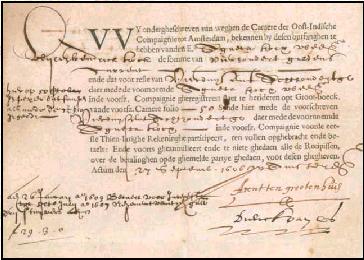
On the the shares of the first emission of shares ever, duly filled out and signed. It is the oldest document as such.
One of the so called Pioneering Companies was set up in 1598 by two merchants of Flemish origin, Pieter van der Hagen and Johan van der Veeken. They took the initiative to equip a small fleet of five ships to set sail for Asia. On June 27, 1598, the Hoop (Hope), Geloof (Faith), Trouw (Loyalty), de Blijde Boodschap (the Glad Tidings) and the Liefde (Love) left the Dutch city of Rotterdam in an attempt to follow the 'Spanish' western route to Asia via South America and the Straits of Magellan. Only the Trouw and the Liefde would reach their destination. The first ship arrived on the Moluccas, where the crew was captured by the Portuguese. The Liefde reached the Japanese island of Kyushu on April 19, 1600, with less than a quarter of the original crew. The English helmsman William Adams was one of them. Thanks to his writings, the early history of Dutch contacts with Japan is well documented. The Dutch traders - as all foreigners - were distrusted by the Japanese, who did not have high regards of the often red haired and rough sailors and traders. The Dutch were more or less confined to the artificial island of Dejima, connect to the shore by a narrow bridge. Nobody could go unnoticed to or from the island. On some occasions some of the Dutch were allowed to visit the capitol city, all under strict control of the Japanese. However, both sides profited from the presence of the Dutch trading post. They were the only ones to be allowed to have such a position for a long time. One way that the Japanese also profited from the situation was that their knowledge of medicine was very much upgraded. They seemed to have been perplexed by the Dutch medical text books which were richly illustrated with many detailed drawing of the human body. In those days doctors in Holland had already started dissecting human bodies and the results were painstakingly copied by artists. The Japanese were alarmed and awed by these medical text books as they did not think that such savages were competent, apart from handling ships over long distances, to do something sophisticated as that. For a long time the medical books were used by the Japanese, also to teach the new generation of doctors. Even to this day some medical words in the Japanese language are still from Dutch origin, as they had no expressions for those words.
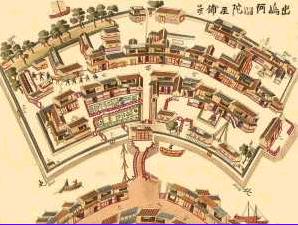
Western Copy of Toshimaya's Woodblock print of the Island of De(s)jima or Deshima
Much more information regarding the Dejima period can be found in URL:
http://batavia.rug.ac.be/Japan/Desjima.htm
In the home page of this web site Dutch and English versions are available: http://batavia.rug.ac.be/
The original trading post Batavia on the island of Java in the Indonesian
Archipelago remained the colonial capital for a long time until 1949, when
threehunderdforty years after its foundation the government of Indonesia renamed the city
into Jakarta, capital of the independent republic.
An interesting has been going on for some time. The Batavia Yard in Lelystad,
the Netherlands, is foremost a centre for traditional shipbuilding. Since 1985
over 200 young people have made, under the guidance of Master-shipbuilder Willem
Vos, an authentic reconstruction of the VOC-merchantman Batavia from 1628. The keynote
has been to achieve the most authentic reconstruction by using traditional materials
and following the building methods of the day.
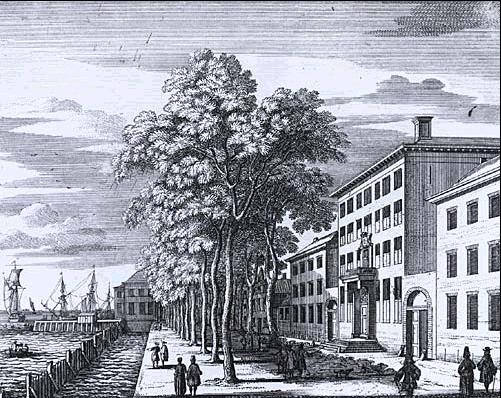
De Boompjes, a quay still present in the city of Rotterdam, with the East India House of the Rotterdam Chamber of the VOC. The drawing was made in about 1700 by Petrus Schenk. The East Indian house was destroyed by the German bombardment of May 14, 1940.
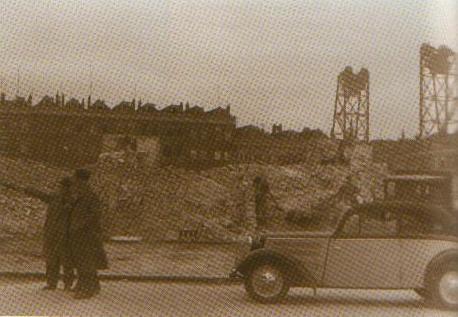
The German bombardment, on that same day, also was responsible of destroying the offices of Radio Holland, the company that was responsible for delivery and maintenance of radio and navigation equipment on board most Dutch ships, including supplying a radio officer.

This is also the Boompjes in Rotterdam showing my uncle Willem van Eeuwen to the left on the ruins of what once was the Radio Holland office building in June 1940. May be the Radio Holland building was one the same spot as the East Indian House, anyway it was very close to that location. It proofs that 'anything is connected to anything' in this small world!
The story of the VOC is a very fascinating story and if you
are interested much information can be found on the following links:
http://www.londoh.com/voc_links.htm
The VOC and Formosa, called Taiwan nowadays. Information can be found here:
http://www.iias.nl/iiasn/iiasn8/eastasia/formosa.html
In total there were some thirty or forty VOC sites in India. Visit the following site:
http://www.iias.nl/iiasn/iiasn6/south/voc.html
http://www.geocities.com/Athens/Styx/6497/voc.html
Two of the VOC's ships discovered Australia's existence. Captain Willem Janszoon with his small ship Duyfken discovered Australia in 1606 and Captain Dirck Hartogh with his ship Eendracht discovered Western Australia in 1616. Many other VOC ships encountered Western Australia's coast and some shipwrecked, leaving behind survivors who had to carve out an existence as best they could possibly with the help of local inhabitants. The first Dutch immigrants settling in Australia....!? The VOC was also responsible for practically all of the charting of the western half of Australia's coastline, when it was still called New Holland, which eventually led to its European settlement some 200 years later. As such the VOC has played an important part in the formation of Australia a fact not fully appreciated even by modern Australians.
http://www.atem.nl/VOC/VOC004.HTM Dutch language information on Scheepssoldijboeken (Ship's salary books)
